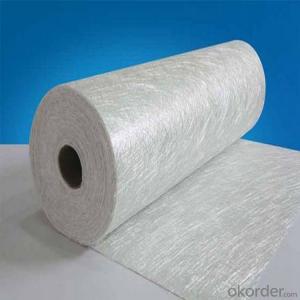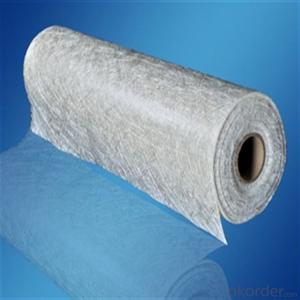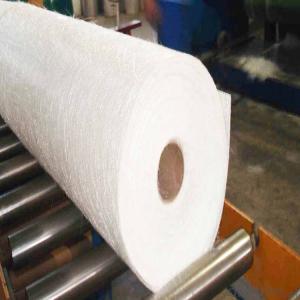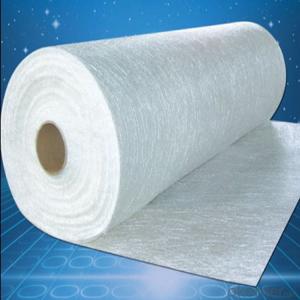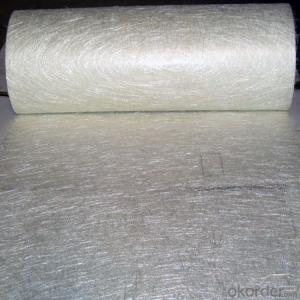Raw Materials Reinforced Fiberglass Chop Strand Mat, Glass Fiber Fabric
- Loading Port:
- China main port
- Payment Terms:
- TT OR LC
- Min Order Qty:
- 1 kg
- Supply Capability:
- 10000 kg/month
OKorder Service Pledge
OKorder Financial Service
You Might Also Like
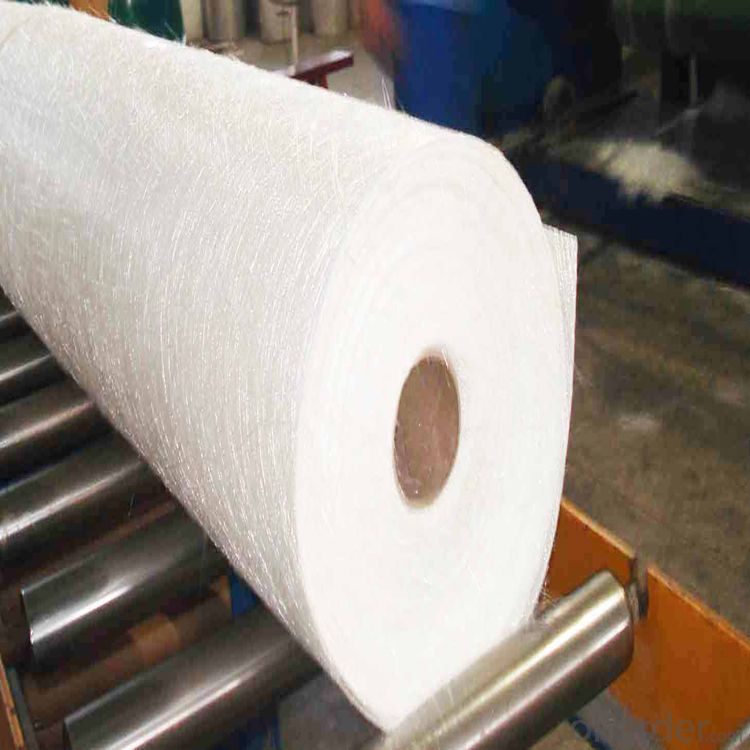
Product Description:
Fiberglass Chopped Strand Mat is fine strand reinforcement material made from E-glass cut fibers laid in a random pattern and bonded with powder or emulsion binder.
It is easy to handle and has excellent moulding performance.
Also, it has rapid resin penetration together with a fast strand wet out time.
The mat also brings a highly translucent finished laminates.
Also,the fine strand input makes the fiber prominence at the finished laminates surface extremely low.
Features
1.Excellent weight uniformity
2.Fast wet out
3.Easy air release
4.Excellent transparency of finished products
5.Excellent laminate
6.Low resin consumption
Application
1.Translucent roof panel
2.chemical storage tanks
3.FRP pipes
4.Boat hulls
5.Decks
6.Truck body panel
7.Cooling towers
8.Corrosion resistand
Specifications:
Item | Over Density | Moisture Content | Chop Density | Polyester Yarn | Width |
(g/m2) | (%) | (g/m2) | (g/m2) | (mm) | |
EMK300 | 309.5 | ≤0.15 | 300 | 9.5 | 50-3300 |
EMK380 | 399 | 380 | 19 | ||
EMK450 | 459.5 | 450 | 9.5 | ||
EMK450 | 469 | 450 | 19 | ||
EMC0020 | 620.9 | 601.9 | 19 | ||
EMC0030 | 909.5 | 900 | 9.5 |
Special products are available according to customer’s requirement.
Product Packaging:
Each Surface Tissue is wound onto a paper tube which has an inside diameter of 76mm and the mat roll has a diameter of 330mm. The mat roll is wrapped up with plastic film,and then packed in a cardboard box or wrapped up with kraft paper. The rolls can be vertically or horizontally placed. For transportation, the rolls can be loaded into a cantainer directly or on pallets.
Quantity
20'GP Container:About 10000kgs
40'HP Container:Aboout 23100kgs
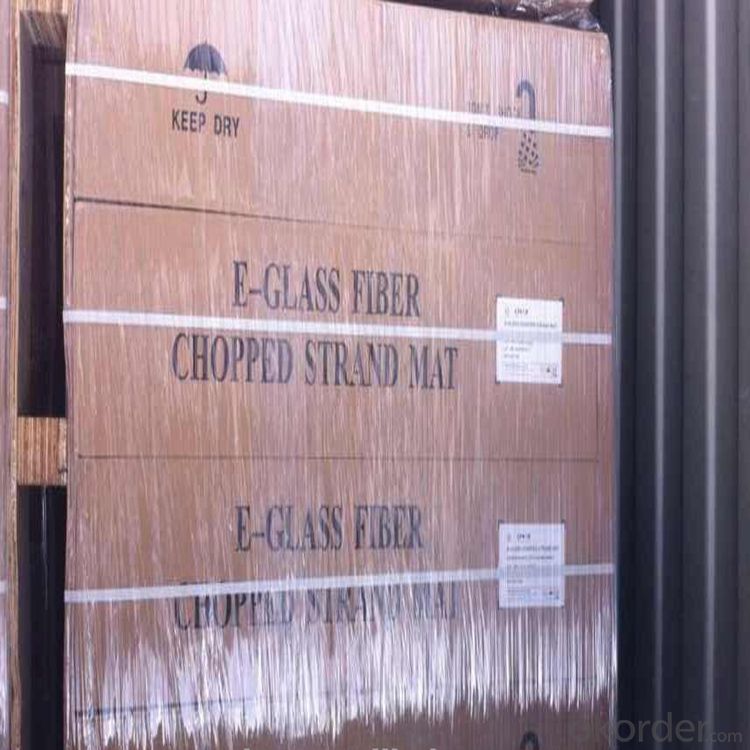
Product Storage:
Unless otherwise specified, Chopped Strand Mat should be stored in a dry, cool and rain-proof area. It is recommended that the room temperature and humidity should be always maintained at 15℃~35℃ and 50%~75% respectively.
Company Information
CNBM (China National Building Material) Group is the largest comprehensive building materials group in China that in integrate scientific research, manufacturing and logistics into one entity. The largest building materials and equipment specialists in China. Upon State Council approval, today CNBM owned more than 300 subordinate manufacturing factories and servicing companies. There are 6 fully owned public listed companies and 11 partially owned with substantial shares public listed companies. In many of these fields, CNBM is playing the leading role in the building industry in the country.

Our Service:
1.Any inquiry will be replied within 24 hours.
2.Professional manufacturer.
1) Print logo in the products;
2) The size and specification can be produce and design according to your demand.
3.High quality,fashion designs,reasonable and competitive price,fast lead time.
4.After-sale service
1) All products will have been strictly quality check in house before packing.
2) All products will be well packed before shipping.
3) All our products have 10 years rot resistance.
5.Faster delivery:sample order in stock,and 15-20 days for bulk production.
6.Payment:you can pay for the order via:T/T,Western Union,MoneyGram,L/C etc.
FAQ:
which kind of glass fiber sample and materials can you provide?
We can provide the glass fiber and glass fiber down stream products samples of E glass, C glass, ECR glass, High alkali glass. The products includes single end roving, assembled roving for different applications( Piping, SMC, panel, winding mill plate) , chop strand for BMC, engineering plastic (PA, PPA, PPT, POM, etc), chop strand mat (from 100gsm-900gsm) for automobile and water tank, etc, woven roving (270gsm-800gsm), surface tissue (25-50gsm), multi-axial fabric of different unit weight.
- Q:Can fiberglass chopped strand be used in the production of electrical insulators?
- Fiberglass chopped strand is indeed applicable in the manufacturing of electrical insulators. This versatile material boasts exceptional electrical insulation properties. With its high dielectric strength, it effectively opposes the flow of electrical current and prevents any leakage. Furthermore, fiberglass exhibits resistance against moisture and chemicals, rendering it suitable for a wide range of electrical applications. In the production of electrical insulators, fiberglass chopped strand is typically combined with a resin matrix to form a composite material that provides insulation and mechanical strength. This composite can be molded into various shapes and sizes to cater to the specific requirements of electrical insulators utilized in diverse applications. All in all, fiberglass chopped strand proves to be a dependable and cost-efficient option for the production of electrical insulators.
- Q:How is fiberglass chopped strand used in the packaging industry?
- Fiberglass chopped strand is commonly used in the packaging industry as a reinforcement material for various packaging components. It is often added to plastic resins or polymers to enhance their strength, durability, and impact resistance. This helps in creating packaging materials that can withstand rough handling, stacking, and transportation without getting damaged. Additionally, fiberglass chopped strand can also be used as a filler material in packaging products to improve their dimensional stability and reduce the overall weight of the packaging.
- Q:Can fiberglass chopped strand be used in roofing materials?
- Yes, fiberglass chopped strand can be used in roofing materials. Fiberglass chopped strand is a common reinforcement material used in the manufacturing of various roofing materials such as shingles, tiles, and membranes. It offers excellent strength and durability, making it an ideal choice for withstanding harsh weather conditions and prolonging the lifespan of the roofing system. The chopped strands are typically mixed with other materials such as asphalt or resins to create a composite that enhances the structural integrity and resistance of the roofing materials. Additionally, fiberglass chopped strand is lightweight, fire-resistant, and provides good thermal insulation, which further contributes to its suitability for roofing applications.
- Q:Is fiberglass chopped strand suitable for thermal insulation?
- Indeed, fiberglass chopped strand proves to be an ideal option for thermal insulation purposes. Renowned and extensively utilized, fiberglass stands out due to its exceptional thermal qualities. Its low thermal conductivity allows for efficient heat transfer prevention, ensuring the maintenance of desired temperatures within confined areas. Employing fiberglass in its chopped strand configuration further enhances its insulation capabilities, as it can be effortlessly packed or blown into cavities, forming a seamless and efficient barrier. Moreover, fiberglass chopped strand insulation guarantees safety, as it is non-combustible, rendering it a secure choice for thermal insulation across diverse industries and applications.
- Q:Is fiberglass chopped strand suitable for water tanks?
- Indeed, water tanks can be constructed using fiberglass chopped strand, which is highly suitable for the purpose. Fiberglass, known for its durability and versatility, is frequently employed in the building of water tanks. It possesses corrosion resistance, is lightweight, and boasts a favorable strength-to-weight ratio, rendering it an optimal material for water storage purposes. Furthermore, fiberglass is non-porous and impervious to water absorption, guaranteeing the tank's imperviousness to leaks. The utilization of chopped strand fiberglass further enhances the tank's structural integrity, making it an even more fitting choice for water tank construction.
- Q:How does the fiber content affect the thermal conductivity of fiberglass chopped strand composites?
- The fiber content has a significant impact on the thermal conductivity of fiberglass chopped strand composites. As the fiber content increases, the thermal conductivity decreases. This is because the fibers act as barriers to the flow of heat within the composite material. They create air pockets between the fibers, which serve as insulators, slowing down the transfer of heat. Additionally, the fibers themselves have low thermal conductivity compared to the surrounding matrix material. When the fiber content is low, there are fewer fibers to impede the heat flow, resulting in higher thermal conductivity. Conversely, as the fiber content increases, the density of fibers in the composite increases, creating more barriers and reducing the ability of heat to pass through. Therefore, it can be concluded that higher fiber content in fiberglass chopped strand composites leads to lower thermal conductivity, making them more effective as insulation materials. This property makes fiberglass chopped strand composites suitable for various applications where thermal insulation is required, such as in buildings, automotive components, and aerospace structures.
- Q:What are the electrical conductivity properties of fiberglass chopped strand?
- Glass fiber, also known as fiberglass chopped strand, possesses favorable electrical conductivity characteristics. Comprised of fine glass fibers that are randomly arranged and bound together, it is a non-metallic material. The electrical conductivity of fiberglass chopped strand can be attributed to its glass composition, which is amorphous and has poor electrical conductivity. Nevertheless, its electrical conductivity can be enhanced by introducing certain elements or coatings during the manufacturing process. In its pure state, fiberglass chopped strand exhibits considerable electrical resistance, making it an excellent insulating material. This property proves advantageous in applications requiring electrical insulation, such as in electrical enclosures, circuit boards, and wire and cable insulation. However, fiberglass chopped strand can be tailored to possess specific electrical conductivity properties by incorporating conductive additives or coatings. These additives may include metals like copper or aluminum, carbon fibers, or conductive polymers. By incorporating these conductive materials, the electrical resistance of fiberglass chopped strand can be significantly reduced, thereby improving its ability to conduct electricity. Various factors, including fiber diameter, fiber length, and fiber orientation, can further influence the electrical conductivity properties of fiberglass chopped strand. Generally, shorter fibers and higher fiber concentrations yield improved electrical conductivity. In conclusion, while fiberglass chopped strand is typically an insulating material, it can be modified to exhibit desired electrical conductivity properties through the incorporation of conductive additives or coatings.
- Q:Does fiberglass chopped strand improve the vibration damping properties of composite materials?
- Yes, fiberglass chopped strand can improve the vibration damping properties of composite materials. Fiberglass has inherent damping properties due to its viscoelastic nature, which means it can absorb and dissipate energy when subjected to vibrations. When used as a reinforcement in composite materials, the fiberglass chopped strand enhances the overall damping characteristics of the composites. The random orientation and short length of the chopped strands allow for them to be dispersed throughout the composite matrix, creating an interlocking network that helps to dissipate vibration energy. This interlocking network effectively hinders the propagation of vibration waves, reducing their amplitude and frequency. As a result, the composite material exhibits improved vibration damping properties. Additionally, the high strength and stiffness of fiberglass further contribute to the overall performance of the composite material. By reinforcing the matrix, the fiberglass chopped strand increases the rigidity of the composite, which helps to minimize the magnitude of vibrations. This combination of damping and reinforcement properties makes fiberglass chopped strand an excellent choice for applications where vibration damping is desired. It is important to note that the specific improvement in vibration damping properties may vary depending on the composition and design of the composite material, as well as the amount and distribution of the fiberglass chopped strand. Proper selection and incorporation of the chopped strand are crucial for achieving the desired vibration damping characteristics in composite materials.
- Q:How does the fiber orientation distribution of fiberglass chopped strand affect the properties of composites?
- The properties of composites are greatly influenced by the distribution of fiber orientation in fiberglass chopped strand. This distribution refers to how the fibers are aligned and arranged within the composite material. Firstly, the mechanical properties of the composite are affected by the fiber orientation distribution. Typically, fiberglass chopped strands are randomly oriented within the matrix, creating a three-dimensional network. This random distribution results in isotropic properties, meaning the composite exhibits similar mechanical behavior in all directions. However, if the fibers are aligned in a specific direction, such as unidirectional alignment, the composite becomes anisotropic, meaning it has different mechanical properties in different directions. For example, composites with aligned fibers have improved stiffness and strength along the fiber direction, but reduced properties in other directions. Secondly, the thermal properties of composites are influenced by the fiber orientation distribution. When the fibers are randomly distributed, heat is transferred in multiple directions, leading to isotropic thermal conductivity. Conversely, if the fibers are aligned, heat transfer is more efficient along the fiber axis, resulting in anisotropic thermal conductivity. This anisotropic behavior is advantageous when designing composites for specific applications that require controlled heat dissipation or insulation properties. Thirdly, the fiber orientation distribution affects the electrical properties of composites. Randomly distributed fibers create a conductive network throughout the material, enabling good electrical conductivity in all directions. However, if the fibers are aligned, the electrical conductivity becomes anisotropic, with higher conductivity along the fiber direction. This anisotropic behavior can be advantageous in applications where electrical conductivity needs to be controlled, such as in electronic devices or electromagnetic shielding. Furthermore, the fiber orientation distribution impacts the overall durability and fatigue resistance of composites. Randomly distributed fibers help distribute stress and strain more evenly throughout the material, enhancing its resistance to crack propagation and fatigue failure. In contrast, composites with aligned fibers may experience stress concentrations along the fiber direction, making them more vulnerable to failure under cyclic loading. In conclusion, the fiber orientation distribution of fiberglass chopped strand has a significant impact on the properties of composites. It determines the mechanical, thermal, electrical, and durability characteristics of the material, allowing for tailored composite designs to meet specific application requirements.
- Q:Can fiberglass chopped strand be used in reinforcing concrete?
- Yes, fiberglass chopped strand can be used in reinforcing concrete. Fiberglass chopped strand is a type of reinforcement material that consists of small strands of fiberglass. These strands are typically added to concrete mixtures to enhance the strength and durability of the resulting concrete structure. When fiberglass chopped strand is added to concrete, it helps to distribute the load and stress more evenly throughout the structure. This reinforcement material provides increased tensile strength, impact resistance, and crack control to the concrete. It also improves the overall performance and lifespan of the concrete, making it more resistant to environmental factors such as moisture, temperature changes, and chemical exposure. Fiberglass chopped strand can be easily mixed into the concrete during the batching process. It is commonly used in a variety of concrete applications, including precast concrete products, cast-in-place concrete, and concrete overlays. It is particularly effective in reinforcing thin sections of concrete, such as slabs and overlays, where cracking and shrinkage are more likely to occur. Overall, fiberglass chopped strand is a reliable and cost-effective solution for reinforcing concrete. Its use can significantly improve the strength and durability of concrete structures, making them more resistant to various types of damage and extending their lifespan.
1. Manufacturer Overview |
|
|---|---|
| Location | |
| Year Established | |
| Annual Output Value | |
| Main Markets | |
| Company Certifications | |
2. Manufacturer Certificates |
|
|---|---|
| a) Certification Name | |
| Range | |
| Reference | |
| Validity Period | |
3. Manufacturer Capability |
|
|---|---|
| a)Trade Capacity | |
| Nearest Port | |
| Export Percentage | |
| No.of Employees in Trade Department | |
| Language Spoken: | |
| b)Factory Information | |
| Factory Size: | |
| No. of Production Lines | |
| Contract Manufacturing | |
| Product Price Range | |
Send your message to us
Raw Materials Reinforced Fiberglass Chop Strand Mat, Glass Fiber Fabric
- Loading Port:
- China main port
- Payment Terms:
- TT OR LC
- Min Order Qty:
- 1 kg
- Supply Capability:
- 10000 kg/month
OKorder Service Pledge
OKorder Financial Service
Similar products
New products
Hot products
Hot Searches
Related keywords
